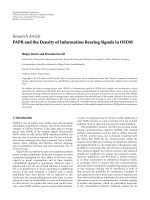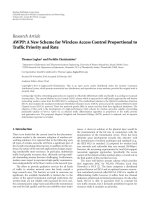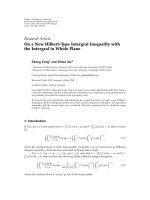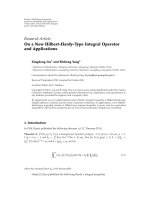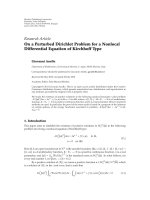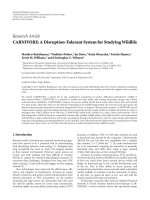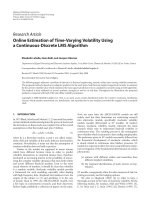Báo cáo hóa học: " Research Article WMicaD: A New Digital Watermarking Technique Using Independent Component Analysis" docx
Bạn đang xem bản rút gọn của tài liệu. Xem và tải ngay bản đầy đủ của tài liệu tại đây (3.31 MB, 9 trang )
Hindawi Publishing Corporation
EURASIP Journal on Advances in Signal Processing
Volume 2008, Article ID 317242, 9 pages
doi:10.1155/2008/317242
Research Article
WMicaD: A New Digital Watermarking Technique Using
Independent Component Analysis
Thang Viet Nguyen, Jagdish Chandra Patra, and Pramod Kumar Meher
School of Computer Engineering, Nanyang Technological University, 50 Nanyang Avenue, Singapore 639798
Correspondence should be addressed to Jagdish Chandra Patra,
Received 24 July 2006; Revised 22 February 2007; Accepted 15 August 2007
Recommended by B. Sankur
This paper proposes a new two-mark watermarking scheme that is based on the independent component analysis (ICA) technique.
The first watermark is used for ownership verification while the second one is used as the copy ID of the image. Using a small-
sized support image, the extraction is carried out on size-reduced level, bringing computational advantage to our method. The
new method, undergoing a variety of experiments, has shown its robustness against attacks and its capability of detecting tampered
area in the image.
Copyright © 2008 Thang Viet Nguyen et al. This is an open access article distributed under the Creative Commons Attribution
License, which permits unrestricted use, distribution, and reproduction in any medium, provided the original work is properly
cited.
1. INTRODUCTION
Digital watermarking, in which some information called
the watermark is embedded directly and imperceptibly into
original data (the so-called work), is one of the effec-
tive techniques to protect digital works from piracy [1, 2].
Once embedded, the watermark is bound to the work and
should be extractable to prove the ownership, even if the
work is modified [3]. Besides, it is preferable if the wa-
termark also contains the tracking information about the
copies of the work, that is, the copy ID. Because of its im-
portance in digital media, watermarking has been exten-
sively studied in recent years, with many approaches such
as Fourier transform, Wavelet transform, QIM (quantization
index modulation), and ICA (independent component anal-
ysis).
The idea of applying ICA to watermarking has been in-
troduced in several studies, such as in the works of Zhang
and Rajan [4], Gonzalez et al. [5], Bounkong et al. [6], and
some others [7–9]. The similarity between ICA and water-
marking schemes and the blind separation ability of ICA are
the reasons that make ICA an attractive approach for water-
marking.
In this contribution, we develop a novel method called
WMicaD (watermarking by independent component anal-
ysis with dual watermark) that aims for the two above-
mentioned goals: verifying the ownership and tracking the
copies. To do it, the WMicaD method employs a dual wa-
termark embedding scheme and an ICA-based extraction
scheme. While the two watermarks allow us to verify the
ownership as well as to track the copy ID, the ICA algorithm
and watermark modification scheme allow us to extract the
watermark with a single small-sized support image, the key
image, without any information about the embedding pa-
rameters. Moreover, since the watermark extraction is car-
ried out on size-reduced images, WMicaD gains computa-
tional advantage. In summary, our proposed method has the
following characteristics.
(i) The size of the key image is much smaller than the
original image. Thus, we need less storage memory
space. Besides, the watermarked image may be made
public if necessary.
(ii) The ICA-based extraction scheme does not require the
original image and the watermarks. Also, the embed-
ding parameters can be any arbitrary numbers.
(iii) The extraction is carried out on the down-sized im-
ages. It provides computational advantage compared
to the extraction scheme with original size of the test
image.
(iv) The proposed watermarking algorithm can serve for
both ownership verification and image authentication.
2 EURASIP Journal on Advances in Signal Processing
Sources Observations
Extracted
signals
Mixing
matrix
Demixing
matrix
Unknown
s
1
s
2
s
N
.
.
.
x
1
x
2
x
N
.
.
.
.
.
.
y
1
y
2
y
N
.
.
.
AB
Figure 1: The ICA mixing and demixing models.
This paper is organized as follows. An overview of ICA
and its similarity with watermarking is shown in Section 2.
The WMicaD embedding and extraction schemes are de-
tailed in Sections 3, 4, 5,and6. We provide the computer
simulations in Section 7. Finally, in Section 8,weconclude
and discuss the issues related to the proposed algorithm.
2. WATERMARKING USING ICA
Independent component analysis (ICA) [10]isanimpor-
tant technique in signal processing whose goal is to unveil
the hidden components from given observations. Assuming
that the observed signals are mixtures of unknown indepen-
dent sources, the ICA is carried out by finding a transform of
the observation so that the new signals are as independent as
possible [11]. Because of its blind extraction ability, many al-
gorithms have been developed for ICA, for example, Infomax
[12], FastICA [13], and ThinICA [14].
Shown in Figure 1 is the full ICA model which includes
a mixing scheme and a demixing scheme. In the mixing
scheme, the observed signals are generated by an unknown
linear combination of the unknown sources. The scheme can
be represented mathematically as
x
= As,(1)
where x
= [x
1
, , x
N
]
T
is a vector of observed signals,
s
= [s
1
, , s
N
]
T
is a vector of original signals, and A
N×N
is a
mixing matrix representing the unknown combination. This
mixing scheme is similar to a watermark embedding scheme
if we consider the work and the watermarks as unknown
sources, and the watermarked images as the observations.
The goal of the ICA demixing scheme is to recover the
hidden sources s
i
, given the observations. It is similar to the
watermark extraction scheme, where the watermarks are ex-
tracted from watermarked images. ICA carries out this task
by maximizing the statistical independence criteria among
the outputs y
1
, , y
N
via a demixing matrix B:
y
= Bx. (2)
When converged, B will be an inverse of A up to some
permutations and scales, and y
1
, , y
N
will be a permuta-
tion of the unknown sources s
1
, , s
N
. That is, if an ICA
demixing scheme is applied on watermarked images, the out-
puts will be the embedded watermarks and the work.
Being interested in the potential of ICA, several au-
thors have focused their studies on ICA-based watermark-
ing [4, 5, 7–9]. As ICA algorithms require enough number of
mixtures to run (the number of mixtures has to be equal to
or more than the number of sources), a common challenge
for ICA-based watermarking methods is to create different
observations from the watermarked images and additional
data. In [4, 5], the authors partitioned the original image into
small blocks. The ICA algorithm was applied on these blocks
to extract the independent components (ICs). Some of the
less significant ICs were replaced by the watermarks. The wa-
termarked image was then constructed from this new set of
ICs. Major disadvantages of this approach, however, are the
need of a large number of ICs and the high computational
workload.
In [7], the authors used the original image and one of
the two watermarks as the additional data. This is not prefer-
able as the original image must be presented whenever ones
want to proof the image ownership. In [9], the original im-
age is not required but another watermarked image embed-
ded by the same watermarks is needed. The extraction can-
not be carried out without this large-size supporting image.
Our proposed WMicaD method attempts to reduce the size
of the supporting image by a watermark modification pro-
cess. The modification is applied on the watermark so that it
reveals different content on different image size.
3. WATERMARK MODIFICATION
In this paper, we treat a gray-level image, I of size M
×N,asa
matrix of M
×N whose entries are the pixel intensity values.
3.1. The downsizing and upsizing operators
The downsizing operator, denoted by D, resizes an image
of size M
× N to k-time smaller images, I
[k](M/k)×(N/k)
=
D(I
M×N
, k). The (m, n)th entry of the size-reduced image is
the average of the pixel values inside a window of size k
× k
of the original image I
M×N
. That is,
I
[k](m,n)
=
1
k
2
k
−1
i=0
k
−1
j=0
I
(km+i,kn+j)
,(3)
where k is a nonzero positive integer, called “resizing factor,”
m = 0,1, ,(M −1/k), and n = 0, 1, ,(N −1/k).
The upsizing operator U, in contrast, duplicates each el-
ement of I
M×N
to every element in a window of size k × k.
The k-time upsized version of I
M×N
is defined as I
[k]
kM
×kN
=
U(I
M×N
, k) whose (m, n)th entry is computed by
I
[k]
(m,n)
= I
(m/k,n/k)
(4)
for all m
= 0, 1, ,(kM −1), n = 0, 1, ,(kN −1), and k is
the “resizing factor.” The “floor” operator
x truncates the
number x to the nearest smaller integer.
3.2. Watermark modification
As introduced in Section 2, we aim to embed the two water-
marks (W
1
and W
2
) into the original image. Hence, in order
ThangVietNguyenetal. 3
Visual masking
Visual masking
S
1
S
2
I
I
+
V
1
V
2
M
1
M
2
W
1
W
2
α
β
γ
D
K
Figure 2: The WMicaD embedding scheme.
to apply ICA algorithm into the extraction scheme, we need
at least three mixtures. However, we only have two available
observations: a watermarked image and a small supporting
image. Simple linear combination of these two images cannot
create three independent mixtures. Therefore, our solution
is to modify the watermarks with certain conditions so that
they reveal different information at different image scales.
The first watermark, W
1
, is modified in such a way that
when it is downsized by a factor k
1
, it produces a small-sized
watermark, W
1[k
1
]
.ButwhenW
1
is downsized by a factor
k
1
k
2
, it produces a nullmatrix. Mathematically, this property
can be expressed as
∅
[k
1
k
2
]
= D
W
1
, k
1
k
2
,(5)
W
1[k
1
]
= D
W
1
, k
1
,(6)
where
∅ denotes a null matrix.
The second watermark, W
2
, is modified so that when we
downsize and subsequently upsize it again with the same fac-
tor, the watermark remains unchanged. Mathematically, this
property can be expressed as
D
W
2
, k
1
=
U
D
W
2
, k
1
k
2
, k
2
. (7)
There are many ways to create the watermarks that sat-
isfy (5), (6), and (7). In the appendices of this paper, we will
introduce a simple modification method to create such wa-
termarks. Also, in Section 5, we will explain in detail the use
of the watermarks W
1
and W
2
.
4. WMICAD EMBEDDING SCHEME
Shown in Figure 2 is the detail of our WMicaD embedding
scheme. A watermarked image I
+
is generated by embedding
two watermarks W
1
and W
2
into the original image, I.At
the same time, a small-sized key image, K, is generated as the
supporting image which will be used later in the watermark
extraction.
We begin the embedding scheme by creating two visual
masks V
1
and V
2
for the two watermarks. As discussed in
[15], the visual masks help us to increase the embedding
strength of the watermarks while maintaining the image’s
quality and watermark’s invisibility. Our visual masks are
computed from the original image, I, using NVF (noise visi-
bility function) technique [15, 16].
ICA
I
+
I
1
I
2
I
3
I
4
D
DU
C
2→1
C
2→1
C
2→1
x
1
x
2
x
3
y
1
y
2
y
3
C
1→2
C
1→2
C
1→2
Y
1
Y
2
Y
3
K
−
+
Figure 3: The WMicaD extraction scheme.
Now, we create the watermarks from given signatures, S
1
and S
2
.VisualmaskV
1
and a modification function M
1
(see
the appendices) are applied on S
1
to generate the first wa-
termark, W
1
, that satisfies (5)and(6). Visual mask V
2
and
modification function M
2
are applied on S
2
to generate the
second watermark, W
2
, that satisfies (7).
In the last step, W
1
and W
2
are inserted into I to produce
watermarked image I
+
. Meanwhile, W
1
is combined with I
and then downsized to produce the key image K.Insum-
mary, steps involved in the embedding scheme are given be-
low.
(1) Create two visual masks V
1
and V
2
by NVF method.
The visual mask V
1
can be different from V
2
by choos-
ing different masking window half-lengths, L
1
=L
2
.
(2) Create watermarks using modification functions
W
i
= M
i
S
i
, V
i
, k
1
, k
2
, i = 1,2, (8)
where k
1
, k
2
are the resizing factors.
(3) Create the watermarked image I
+
and the key image K:
I
+
= I + αW
1
+ βW
2
,(9)
K
= D
I + γW
1
, k
1
. (10)
Parameters α and β are called “embedding strengths” and
γ is called “key-image coefficient.” These parameters can be
any nonzero values in the range of [
−1, 1].
5. WMICAD EXTRACTION SCHEME
Shown in Figure 3 is the detail of our WMicaD extraction
scheme. We extract the two watermarks from the water-
marked image, I
+
, using ICA-based technique with support
from the key image, K. As discussed earlier, firstly, we have
to generate three mixtures and then apply ICA algorithm on
them to receive the outputs. All of these processes will be car-
ried out on size-reduced images.
The steps involved in the WMicaD extraction scheme are
given below.
(1) Downsize the watermarked image I
+
to the size of the
key image K with resizing factor k
1
:
I
1
= D
I
+
, k
1
. (11)
4 EURASIP Journal on Advances in Signal Processing
(2) Create the image I
4
from I
1
and K by applying upsizing
and downsizing operators with a resizing factor k
2
,
I
2
= I
1
−K, (12)
I
3
= D
I
2
, k
2
, (13)
I
4
= U
I
3
, k
2
. (14)
(3) Create1DsignalsfromI
1
, I
4
,andK,
x
1
, x
2
, x
3
T
=
C
2→1
I
1
, C
2→1
I
4
, C
2→1
K
T
, (15)
where C
2→1
denotes a 2D-to-1D operator.
(4) Apply an ICA technique on x
= [x
1
, x
2
, x
3
]
T
to get
three outputs y
= [y
1
, y
2
, y
3
]
T
.
(5) Convert back the outputs y to images,
Y
i
= C
1→2
y
i
, (16)
where i
= 1, 2, 3, and C
1→2
is a 1D-to-2D operator.
Now, let us see how the extraction scheme works on our
special embedded watermarks. From (9)and(11), we have
I
1
= I
[k
1
]
+ αW
1[k
1
]
+ βW
2[k
1
]
, (17)
where W
1[k
1
]
and W
2[k
1
]
are the downsized images of W
1
and
W
2
with resizing factor k
1
. Similarly, we have
K
= I
[k
1
]
+ γW
1[k
1
]
. (18)
Replacing (17)and(18) into (12)and(13) yields
I
2
= (α −γ)W
1[k
1
]
+ βW
2[k
1
]
, (19)
I
3
= (α −γ)D
W
1[k
1
]
, k
2
+ βD
W
2[k
1
]
, k
2
. (20)
Since W
1
satisfies (5)and(6), that is, D(W
1[k
1
]
, k
2
) =
∅
, I
3
can be rewritten as
I
3
= βW
2[k
1
k
2
]
. (21)
Finally, since W
2
satisfies (7), I
4
can be rewritten as
I
4
= βW
2[k
1
]
. (22)
Using (17), (18), and (22), x
= [x
1
, x
2
, x
3
]
T
can be repre-
sented as
⎡
⎢
⎣
x
1
x
2
x
3
⎤
⎥
⎦
=
⎡
⎢
⎣
1 αβ
00β
1 γ 0
⎤
⎥
⎦
⎡
⎢
⎣
t
I
t
W1
t
W2
⎤
⎥
⎦
, (23)
where t
I
, t
W1
,andt
W2
are the three 1D signals, converted
from I
[k
1
]
, W
1[k
1
]
,andW
2[k
1
]
by the 2D-to-1D convert-
ers, respectively. That is, applying ICA algorithm on x
=
[x
1
, x
2
, x
3
]
T
results in the estimates of I
[k
1
]
, W
1[k
1
]
,andW
2[k
1
]
.
And again, we can see that all the actions are taken on the
downsized images, providing substantial computational ad-
vantage to WMicaD.
6. THE POSTPROCESSING SCHEME
As discussed in [11], one of the ambiguities of ICA is about
the output order. In ICA, the outputs will be a permutation
of the original sources. That is, we cannot say if the output y
1
corresponds to the source s
1
, or whether y
2
is an estimate of
s
2
, and so on. Therefore, we develop a postprocessing scheme
for our WMicaD method to identify the corresponding esti-
mates, and to generate the estimates of the signatures from
the estimated watermarks.
The postprocessing scheme is based on the correlation
between each output Y
i
, i = 1,2,3, and the watermarked im-
age I
+
[k
1
]
(in downsized version). To measure the similarity
between two images, we use the absolute correlation coeffi-
cient (abCC). The absolute correlation coefficient between X
and Y (both of size M
×N) is calculated by
r
X,Y
=
s
xy
√
s
xx
s
yy
, (24)
where
s
xy
=
M
i=1
N
j=1
X
(i,j)
−X
Y
(i,j)
−Y
,
s
xx
=
M
i=1
N
j=1
X
(i,j)
−X
2
,
s
yy
=
M
i=1
N
j=1
X
(i,j)
−Y
2
,
X =
1
MN
N
i=1
N
j=1
X
(i,j)
,
Y =
1
MN
M
i=1
N
j=1
Y
(i,j)
.
(25)
The abCC will approach 0 when two images are uncor-
related, and 1 when the two images are very similar to each
other.
Now, we calculate the abCC between each output Y
i
and
I
+
[k
1
]
. Obviously, the output that corresponds to the original
image will have a high abCC value. Whereas, the other out-
puts, which are the watermark’s estimates, will have the abCC
≈ 0 since they are considered independent from the original
image. Hence, taking the two outputs that have the lowest
|r
I
+
[k
1
]
,Y
i
| will give us the estimates of the downsized water-
marks
W
1[K
1
]
and
W
2[K
1
]
.
In the next step, we obtain the original signatures from
the watermark estimates. Since the watermarks are created
by replicating the owner’s signature, S
1
, and the copy ID
number, S
2
, we partition the image Y
i
into l subimages,
Y
i1
, Y
i2
, , Y
il
,eachofsizeM
S
×N
S
,whereM
S
×N
S
is the size
of the owner’s signature. Averaging these subimages yields
the estimate of the signature:
S =
1
l
W
i1
+
W
i2
+ ··· +
W
il
. (26)
ThangVietNguyenetal. 5
(a) (b)
Figure 4: The two original signatures S
1
and S
2
used in the simula-
tions. Both images are of size 16
×64.
(a)
(b)
Figure 5: The images used in the WMicaD experiments. From left
to right: original image I,watermarksW
1
and W
2
, key image K,and
watermarked image I
+
. (a) Expt1: Lena image, (b) Expt2: Baboon
image.
7. PERFORMANCE ANALYSIS
The robustness of the watermarked images was tested
through various simulations under different attacks, includ-
ing JPEG compression, gray-scale reduction, resizing, and
noise addition. Besides, an authentication test was carried
out to verify the WMicaD’s ability of detecting the tampered
area.
7.1. Simulation setup
Two binary images (16
× 64),auniversityname,andacopy
ID, as shown in Figure 4, were used as the signatures during
the embedding scheme. Two well-known gray-scale Lena and
Baboon images, each of size 512
×512, were used as the orig-
inal images in the simulations. The original images, water-
marks, watermarked images, and key images that were gener-
ated by WMicaD embedding scheme are shown in Figure 5.
In the embedding process, peak signal-to-noise ratio
(PSNR) was chosen as the criterion to measure the quality
of the watermarked image. The PSNR betweenanimageI
and its modification
I is defined as
PSNR
= 20log
10
⎛
⎜
⎜
⎝
255
1/(MN)
M
i
=1
N
j
=1
(X
(i,j)
−
X
(i,j)
)
2
⎞
⎟
⎟
⎠
,
(27)
where M
×N is the size of the two images. And for the extrac-
tion process, absolute correlation coefficient (abCC) ((24))
between the estimated signature and its original one,
|r
S,S
|,is
chosen as the performance index.
To maintain the quality of the watermarked image and
the imperceptibility of the watermarks, the embedding coef-
Table 1: The configuration table for the two experiments.
αβγk
1
k
2
L
1
= L
2
PSNR
Lena
−7
256
11
256
9
256
4 2 12 44.99
Baboon
−6
256
9
256
9
256
4 2 10 43.14
ficients α, β and the window half-length L used in the visual
mask function V were monitored so that PSNR
≥ 43dB in
all experiments. The resizing factors k
1
and k
2
were also ap-
propriately selected so that the key image K is small enough
while the watermarks still have adequate details. Details of
the parameters are provided in Ta bl e 1.
With the chosen parameters, there is no noticeable dif-
ference between the original and watermarked images (see
Figure 5). Moreover, the size of the key image (128
× 128) is
16 times reduced from the original 512
×512.
In the next step, test images were generated by applying
different attacks/modifications on the watermarked images.
The WMicaD extraction and postprocessing scheme were
carried out on the test images to estimate the signatures. The
estimated signatures were then compared with the original
ones, using abCC as the performance index to evaluate the
quality of the estimation. In addition, we repeated the simu-
lations with different ICA algorithms, such as SOBI (second-
order blind identification) [17], JADETD (joint approximate
diagonalization of eigen matrices with time delays) [18], and
FPICA (fixed-point ICA) [13], in order to get a more general
evaluation. It turned out that their results are almost identi-
cal. Thus, in this paper, we only show those simulations that
were carried out with SOBI.
7.2. Common modification test
In this simulation, we tested the WMicaD method with three
common image processing techniques: JPEG compression,
gray-scale reduction, and resizing. A JPEG compression tool
was used to compress the watermarked images with qual-
ity factor ranging from 90% down to 10%. In gray-scale
reduction, the gray level was reduced from 256 down to
128, 64, , 8 levels. And in resizing tests, the images were
rescaled from 512
× 512 down to 128 × 128, and up to
1024
×1024.
The results of WMicaD on the three tests are shown
in Figure 6 and some illustrations of the estimated signa-
tures are shown in Figure 7. In the two figures, “Expt1” and
“Expt2” denote the performance plots of our experiments
on the Lena and Baboon images, respectively. The symbols
“
−W1” and “−W2” represent the results on the first and sec-
ond watermarks, respectively. As we can see, WMicaD pro-
ducedgoodperformanceonallexperiences.Thequalityof
the estimates, in terms of abCC with the original signatures,
is high even when the JPEG quality factor or the gray level is
reduced to low value. Among the three modifications, simu-
lations on resizing yielded the worst performance. It is prob-
ably due to the destruction of the first watermark’s properties
6 EURASIP Journal on Advances in Signal Processing
102030405060708090
JPEG quality factor (%)
0
0.2
0.4
0.6
0.8
1
Absolute correlation coefficient
Expt1-W
1
Expt1-W
2
Expt2-W
1
Expt2-W
2
Cox-DCT
Langelaar-spa
Wan g-DWT
(a)
8163264128256
Gray/intensity level
0
0.2
0.4
0.6
0.8
1
Absolute correlation coefficient
Expt1-W
1
Expt1-W
2
Expt2-W
1
Expt2-W
2
Cox-DCT
Langelaar-spa
Wan g-DWT
(b)
50100150200
Resizing scale (%)
0
0.2
0.4
0.6
0.8
1
Absolute correlation coefficient
Expt1-W
1
Expt1-W
2
Expt2-W
1
Expt2-W
2
Cox-DCT
Langelaar-spa
Wan g-DWT
(c)
Figure 6: The performance results of WMicaD on three common attacks. (a) JPEG compression, (b) gray-level reduction, and (c) resizing.
Expt1: Lena image; Expt2: Baboon image; W
1
:firstwatermark;W
2
:secondwatermark.
(a) (b)
Figure 7: The estimated signatures by WMicaD extraction. From
left to right: JPEG compression with quality factor of 50%, gray-
level reduction down to 128, and resizing to the size of 384
× 384.
(a) Experiment with Lena image and (b) Baboon image.
Table 2: Noise configuration table.
Gaussian Mean μ = 0, variance σ
2
= [0 − 0.05]
S&P Noise density [0 − 0.05]
Multiplicative
Uniform noise
Mean μ
= 0, variance σ
2
= [0 − 0.05]
(5)and(6) when the image is resized, that is, pixel values are
interpolated.
For further investigation, we compared the proposed
method with several well-known watermarking techniques
that work on different processing domains [19]. These tech-
niques include a discrete cosine transform algorithm Cox-
DCT [20], a spatial domain algorithm Langelaar-spa [21],
and a discrete wavelet transform algorithm Wang-DWT [22].
The Lena images (in Expt1) were used as the original images.
Our copy ID signature (the number sequence) was chosen as
the watermark. After the embedding process, the distortions
of the watermarked images in terms of PSNR were found
to be 38.4dB,34.2dB,and36.7 dB for the Cox-DCT, Wang-
DWT,andLangelaar-spa, respectively. It may be noted that
in our experiments, the PSNR is found to be 44.9dB and
43.1 dB for Expt1 and Expt2 (see Tab le 1). The performance
results of the watermark extraction were computed in term
of the absolute correlation coefficient and they are shown in
Figure 6.AsitcanbeseeninFigure 6,WMicaDprovided
a competitive performance; it even yielded better results in
JPEG and gray-level reduction tests. These are very encour-
aging results, considering that WMicaD uses two watermarks
that are overlapped on each other.
7.3. Addition-of-noise test
From some points of view, an attack to the watermarked
image can be considered as a noise being added to the im-
age. Therefore, in this section, we investigate the perfor-
mance of WMicaD under different types of noise, including
Gaussian-noise, “salt and pepper” (S&P) noise, and multi-
plicative noise. Noise range and properties used in the simu-
lations are presented in Ta bl e 2 .
The simulation results of WMicaD on the noise tests
are shown in Figure 8. The method provided good perfor-
mance on the “S&P” noise and multiplicative noise exper-
iments but not very impressive performance on Gaussian-
noise test. This can be explained from the ICA property. As
discussed in [11],inordertogetagoodICAestimation,the
source signals should be non-Gaussian. Therefore, when the
Gaussian-noise was added, it made the sources more Gaus-
sian and hence, a poor performance of the ICA-based extrac-
tion scheme.
More simulations on image rotation, cropping, bright-
ness and contrast adjustments, and filtering have been car-
ried out to measure the performance of WMicaD [16]. The
method produces very good result on the brightness and
contrast adjustment attacks. In the desynchronization at-
tacks, such as rotation and cropping, WMicaD performance
is not as good as on the JPEG compression test, but it is better
than in the Gaussian-noise attack. For example, in rotation
attack, we assumed that the rotation angle was unnoticeable
to the extractor, that is, no preinverse rotation operation was
applied. The extraction is carried out directly on the rotated
image. The results were encouraging, and the estimated sig-
natures are still recognizable even when the image was ro-
tated by 0.25 degree.
ThangVietNguyenetal. 7
0.050.040.030.020.010
Gaussian noise variance
0
0.2
0.4
0.6
0.8
1
Absolute correlation coefficient
Expt1-W
1
Expt1-W
2
Expt2-W
1
Expt2-W
2
(a)
0.050.040.030.020.010
Salt and pepper noise density
0
0.2
0.4
0.6
0.8
1
Absolute correlation coefficient
Expt1-W
1
Expt1-W
2
Expt2-W
1
Expt2-W
2
(b)
0.050.040.030.020.010
Multiplicative noise variance
0
0.2
0.4
0.6
0.8
1
Absolute correlation coefficient
Expt1-W
1
Expt1-W
2
Expt2-W
1
Expt2-W
2
(c)
Figure 8: The performance results of WMicaD on noise tests. (a) Gaussian-noise, (b) S&P noise, and (c) multiplicative noise. Expt1: Lena
image; Expt2: Baboon image; W
1
:firstwatermark;W
2
:secondwatermark.
Inserted place
Copied area
Figure 9: The image used in the tampering test. A small portion of
the Lena image is copied and inserted in to another place (the tam-
pering area is magnified and shown on the left side of the tampered
image).
7.4. WMicaD for detection of tampered area
The previous section has shown the ability of WMicaD in
verifying the ownership. In this section, another ability of
WMicaD in image authentication is introduced. The follow-
ing experiment will demonstrate how WMicaD method is
able to detect the tampered area in the image.
Shown in Figure 9 is Lena image that was tampered by
a small portion of the image (the feather portion in the
hat’s tail area). This portion was copied and maliciously
overwritten to another similar place in order to make it un-
detectable by naked eyes.
7.4.1. Detecting the tampered area
Now, we carry out the extraction scheme and carefully ob-
serve the three output images Y
1
, Y
2
,andY
3
.Asitisshown
in Figure 10, the tampered area, even if small, is clearly no-
ticeable in the watermark estimates, with the pixel values of
the tampered area being much higher than the rest of the im-
ages.
(a) (b) (c)
Figure 10: Three output images Y
1
, Y
2
,andY
3
of WMicaD in the
tampering test (all images are of size 128
×128). The tampered area
can be observed in the outputs Y
2
and Y
3
which correspond to the
two watermark estimates.
(a) (b) (c)
Figure 11: The estimated watermarks and signatures after the tam-
pered area is corrected. (a) The first watermark, (b) the second wa-
termark, and (c) the two estimated signatures.
7.4.2. Recovering the signatures
After successfully detecting the tampered area, WMicaD is
still able to extract the signature from the tampered image by
doing an additional step before carrying out the postprocess-
ing scheme. Here, we replace the pixel values in the tampered
area (the area where pixel values are significantly high) by the
average values of the other pixels (the pixels that are not in-
side the tampered area). Next, we quantize all the pixels of
the image to 256 gray level. Finally, we put the corrected im-
age to the postprocessing scheme to estimate the signatures.
AndasitisshowninFigure 11, the estimated watermarks
and signatures are clearly visible and easy to recognize.
8 EURASIP Journal on Advances in Signal Processing
S
1
U(S
1
,2)
Z
1
Z
2
£
T
1
◦ £
U(S
1
, k
1
)
W
1
46 4466
4466
1
−11−1
−11−11
4
−46−6
−44−66
44
−4 −46 6−6 −6
44
−4 −46 6−6 −6
−4 −44 4−6 −66 6
−4 −44 4−6 −66 6
Figure 12: An example of the first watermark modification scheme
M
1
.AwatermarkW
1
of size 8 ×4 is generated from an author sig-
nature S
1
of size 2 ×1. Resizing factor is k
1
= k
2
= 2.
8. DISCUSSION AND CONCLUSION
In this paper, we have proposed a novel watermarking
method called WMicaD that embeds two watermarks into
the host image. The unique two-watermark embedding
scheme and the ICA-based extraction scheme have brought
many interesting properties to WMicaD.
Firstly, this dual watermark embedding scheme allows us
to achieve two goals at the same time: verifying the owner-
ship of the image and tracking the copy ID of the original
image. Unlike other watermarking algorithms that use a se-
quence of numbers as a single watermark, we apply images as
the watermarks. Hence, at the extraction side, the estimated
signatures can be easily verified by visual inspection. In ad-
dition, overlapping of watermarks makes them harder to be
recognized in the host image.
Secondly, utilization of specially tailored watermarks and
ICA algorithm in the extraction scheme makes it possible
to estimate the watermarks without the original image, and
without any information about the embedding parameters.
Please note that while ICA is considered as a blind separa-
tion method, our WMicaD extraction is not considered as a
totally blind watermarking extraction, since it uses a small
supporting key image. We can embed the watermark with
different embedding strengths (the alpha and beta parame-
ters), and different copy IDs (the second watermark) on dif-
ferent image copies. Since all of the three parameters (alpha,
beta, and gamma) can be changed in every image, it is almost
impossible for the attackers to know these parameters. Thus,
it helps to prevent the watermarks from being discovered or
removed.
Theoretically, carrying out the extraction on size-reduced
images brings to WMicaD a computational advantage. As
seen in the simulations, the size of images was reduced by
4
× 4 times, resulting in a much more faster processing time
in comparison with the extraction on the original images.
Please note that if the other competitive algorithm also ap-
plies down-sizing operation before carrying out the water-
mark extraction, then our WMicaD might not have clear
computational advantages. However, not every algorithm
can carry out the extraction on the down-sized images. And
even if it is possible, the quality of the estimated signatures
is another topic that needs further investigation. In addition,
size-reduced images also prevent the attackers from remov-
ing the watermarks from the host image, since the small-size
estimatedoutputsaremuchdifferent from the original one.
Through the simulations, we have used several water-
marking algorithms for performance comparison using ab-
S
2
U(S
2
, k
1
k
2
)
U(S
2
, k
2
)
W
2[k
1
]
W
2
4 6
4466
4466
44446666
44446666
44446666
44446666
Figure 13: An example of the second watermark modification
scheme M
2
.AwatermarkW
2
of size 8 × 4 is generated from an
author signature S
2
of size 2 ×1. Resizing factor is k
1
= k
2
= 2.
solute correlation coefficient (abCC) as a performance in-
dex. It is good but not a perfect measure. Sometimes, an esti-
mate with poor abCC is easy to observe than one with higher
abCC. Also, since we are using a two-watermark embedding
scheme and carrying out the extraction on size-reduced im-
age, it is hard to have an absolute comparison. The compari-
son used in experiments should be considered as an illustra-
tion for our WMicaD performance. In addition, the perfor-
mance is varied, depending on the content of the two water-
marksaswellastheoriginalimage.
APPENDICES
A. FIRST WATERMARK MODIFICATION
The goal of the first watermark modification function, M
1
,
is to generate a watermark, W
1
, from the owner’s signature
so that the watermark satisfies (5)and(6). Details of the
scheme are provided in the following paragraphs and shown
in Figure 12.
Let S
1
be an image of size (M/k
1
k
2
)×(N/k
1
k
2
) that repre-
sents the owner signature. The scheme to construct the wa-
termark W
1
from the owner’s signature is described by
W
1
= U
U
S
1
, k
2
•£, k
1
. (A.1)
First, the signature S
1
is upsized by a factor k
2
to create a
matrix Z
1
. Second, Z
1
is multiplied element by element with
a “chessboard” matrix £ to produce Z
2
. Finally, Z
2
is upsized
by a factor k
1
to generate the watermark W
1
.Itcanbeseen
that when W
1
is downsized by k
1
k
2
,itwillresultinanull
matrix satisfying (5). In this scheme, the chessboard matrix
£isamatrixwhose(m, n)th entry is defined by
£
(m,n)
=
1if(m + n) = even,
−1 otherwise,
(A.2)
and the (m, n)th entry of the element-by-element product
•
is computed by
Z
2(m,n)
= Z
1(m,n)
£
(m,n)
. (A.3)
B. SECOND WATERMARK MODIFICATION
The second modification function M
2
is to create a water-
mark W
2
that satisfies (7). Beginning with a signature S
2
of
size (M/k
1
k
2
) ×(N/k
1
k
2
), we apply the upsizing operator U
on S
2
with resizing factors k
1
k
2
to obtain
W
2
= U
S
2
, k
1
k
2
. (B.1)
ThangVietNguyenetal. 9
Shown in Figure 13 is an illustration of the second modi-
fication scheme, M
2
. The second watermark W
2
of size 8 ×4
is constructed from a signature S
2
of size 2×1 by an upsizing
operator U with the resizing factors k
1
= 2andk
2
= 2. It is
easy to see that the generated watermark W
2
satisfies (7).
REFERENCES
[1]I.J.Cox,M.L.Miller,andJ.A.Bloom,Digital Watermark-
ing, edited by E. Fox, Morgan Kaufmann, San Francisco, Calif,
USA, 1st edition, 2001.
[2] F. Hartung and M. Kutter, “Multimedia watermarking tech-
niques,” Proceedings of the IEEE, vol. 87, no. 7, pp. 1079–1107,
1999.
[3] P. Moulin and J. A. O’Sullivan, “Information-theoretic analy-
sis of information hiding,” IEEE Transactions on Information
Theory, vol. 49, no. 3, pp. 563–593, 2003.
[4] S. Zhang and P. K. Rajan, “Independent component analysis
of digital image watermarking,” in Proceedings of the IEEE In-
ternational Symposium on Circuits and Systems (ISCAS ’02),
vol. 3, pp. 217–220, Phoenix, Ariz, USA, May 2002.
[5] F. J. González-Serrano, H. Y. Molina-Bulla, and J. J. Murillo-
Fuentes, “Independent component analysis applied to digital
image watermarking,” in Proceedings of the IEEE International
Conference on Acoustics, Speech, and Signal Processing (ICASSP
’01), vol. 3, pp. 1997–2000, Salt Lake, Utah, USA, May 2001.
[6] S. Bounkong, B. Toch, D. Saad, and D. Lowe, “ICA for water-
marking digital images,” Journal of Machine Learning Research,
vol. 4, no. 7-8, pp. 1471–1498, 2003.
[7] M. Shen, X. Zhang, L. Sun, P. J. Beadle, and F. H. Y. Chan, “A
method for digital image watermarking using ICA,” in Pro-
ceedings of the 4th International Symposium on Independent
Component Analysis and Blind Signal Separation (ICA ’03),pp.
209–214, Nara, Japan, April 2003.
[8] D. Yu, F. Sattar, and K K. Ma, “Watermark detection and
extraction using independent component analysis method,”
EURASIP Journal on Applied Signal Processing, vol. 2002, no. 1,
pp. 92–104, 2002.
[9] D. Yu. and F. Sattar, “A new blind watermarking technique
based on independent component analysis,” in Digital Water-
marking: 1st International Workshop (IWDW ’03), vol. 2613 of
Lecture Notes in Computer Science, pp. 37–73, Springer, Berlin,
Germany, 2003.
[10] P. Comon, “Independent component analysis, a new con-
cept?” Signal Processing, vol. 36, no. 3, pp. 287–314, 1994.
[11] A. Cichocki and S I. Amari, Adaptive Blind Signal and Image
Processing, John Wiley & Sons, New York, NY, USA, 2002.
[12] A. J. Bell and T. J. Sejnowski, “An information-maximization
approach to blind separation and blind deconvolution,” Neu-
ral Computation, vol. 7, no. 6, pp. 1129–1159, 1995.
[13] A. Hyvärinen, “Fast and robust fixed-point algorithms for in-
dependent component analysis,” IEEE Transactions on Neural
Networks, vol. 10, no. 3, pp. 626–634, 1999.
[14] S. A. Cruces and A. Cichocki, “Combining blind source extrac-
tion with joint approximate diagonalization: thin algorithms
for ICA,” in Proceedings of the 4th International Symposium on
Independent Component Analysis and Blind Signal Separation
(ICA ’03), pp. 463–468, Nara, Japan, April 2003.
[15] S. Voloshynovskiy, A. Herrigel, N. Baumgaertner, and T. Pun,
“A stochastic approach to content adaptive digital imagewater-
marking,” in Proceedings of the 3rd International Workshop on
Information Hiding (IH ’99), pp. 212–236, Dresden, Germany,
September-October 1999.
[16] T. V. Nguyen, “Studies on independent component analysis for
watermarking and nonlinear blind source separation,” Ph.D.
dissertation, School of Computer Engineering, Nanyang Tech-
nological University, Nanyang Avenue, Singapore, May 2007.
[17] A. Belouchrani, K. Abed-Meraim, J F. Cardoso, and E.
Moulines, “A blind source separation technique using second-
order statistics,” IEEE Transactions on Signal Processing, vol. 45,
no. 2, pp. 434–444, 1997.
[18] P. Georgiev and A. Chichocki, “Robust independent com-
ponent analysis via time-delayed cumulant functions,” IEICE
Transactions on Fundamentals of Electronics, vol. E86-A, no. 3,
pp. 573–579, 2003.
[19] P. Meerwald, “Digital image watermarking in the wavelet
transform domain,” M.S. thesis, University of Salzburg,
Salzburg, Austria, January 2001.
[20]I.J.Cox,J.Kilian,F.T.Leighton,andT.Shamoon,“Secure
spread spectrum watermarking for multimedia,” IEEE Trans-
actions on Image Processing, vol. 6, no. 12, pp. 1673–1687, 1997.
[21] G. C. Langelaar, J. C. A. van der Lubbe, and R. L. Lagendijk,
“Robust labeling methods for copy protection of images,”
in Storage and Retrieval for Image and Video Databases V,
vol. 3022 of Proceedings of SPIE, pp. 298–309, San Jose, Calif,
USA, February 1997.
[22] H J. M. Wang, P C. Su, and C C. J. Kuo, “Wavelet-based dig-
ital image watermarking,” Optics Express, vol. 3, no. 12, pp.
491–496, 1998.
